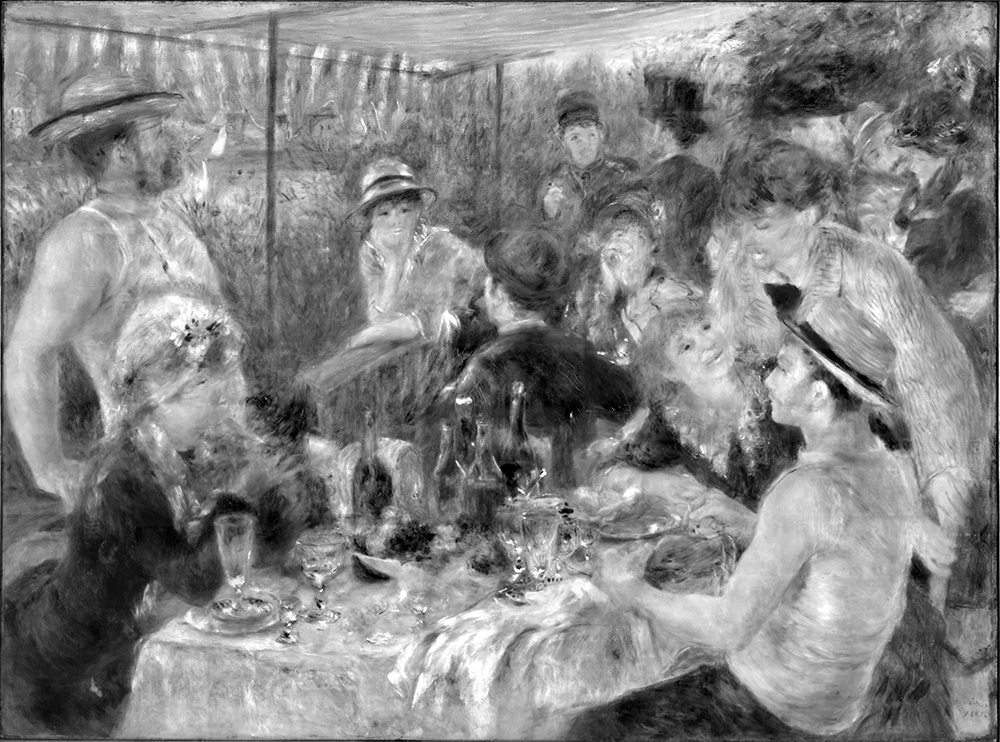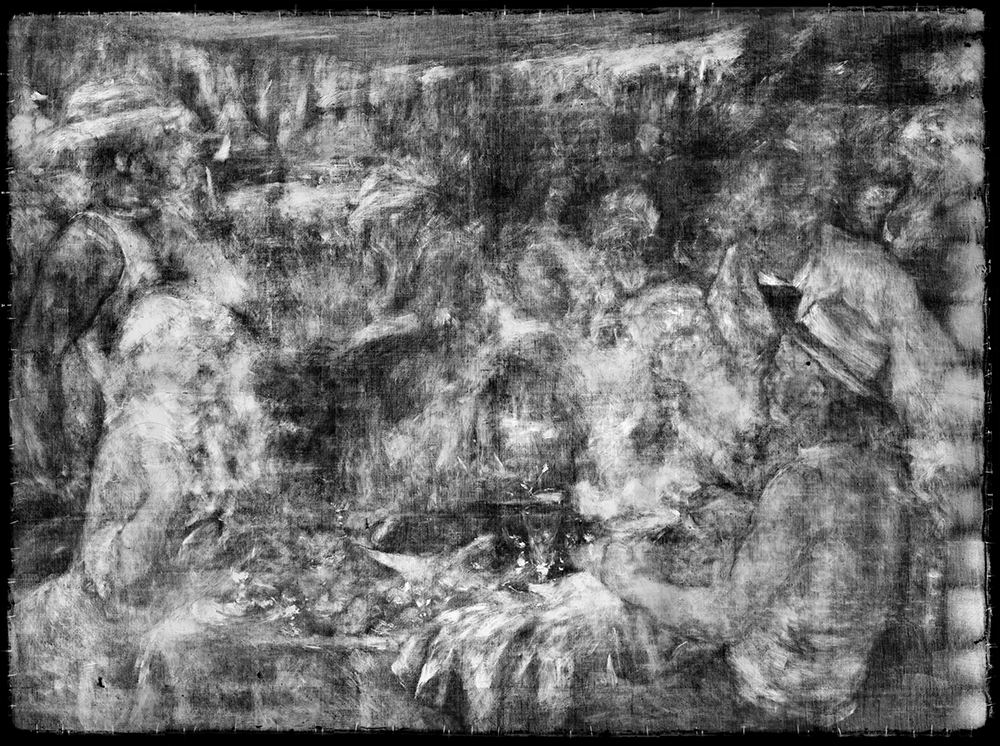Luncheon of the Boating Party
Explore fresh findings from a technical analysis of Luncheon of the Boating Party through an interactive feature and more
The First Technical Study
The first technical study of Renoir’s Luncheon of the Boating Party was published in conjunction with The Phillips Collection’s 1996 exhibition Impressionists on the Seine. Twenty years later, in preparation for Renoir and Friends, a fresh assessment of the picture was undertaken using improved X-radiographic and infrared images and new paint cross-sections. [1]
The allure of the painting lies in Renoir’s ability to capture the moment of friends casually enjoying an afternoon at a restaurant on the Seine. What this in-depth examination shows is that he did so only after multiple revisions. We don’t know how many people posed at any one sitting, but we assume they came in small groups or perhaps individually. [2] While working on the painting, Renoir wrote to Paul Berard about friends coming and going, complaining about how difficult it was to finish it, since “Deudon, who was meant to come, has not shown up and I have not seen anyone since your trip. I do not know if Ephrussi is back; I am sacrificing this week too since I have done all I can and I will return to my portraits … when I will be able to leave I have no idea and I will not fix a date. I believe I will continue to be delayed and in that case you will be back before me.” [3]
Much of the painting’s success lies in the convincing interaction that Renoir creates among his models. Their arrangement in twos and threes leads the eye across the table and through the picture to the back of the balcony. It is the complexity of the scene that makes it so intriguing, and demonstrates the painter’s mastery of strong compositional skills. No preparatory drawings are known to exist and little underdrawing is apparent in the infrared image; it seems as if the artist developed the work directly on the canvas, making changes as the picture evolved. In the same letter to Berard, he recounts this struggle, saying he had to remove a figure “and I no longer know where I am with it except that it is annoying me more and more.” [4]
Under raking light, we can identify the passages where changes were made by the textured brushstrokes under the top layer of paint that bear no relationship to the final picture. Earlier states of sitters and alterations throughout the picture are also detectable in the X-radiograph and the infrared image (see below). When studied under high magnification through a microscope, distinctly different colors in the underlying layers are visible inside drying cracks. The very existence of drying cracks [5] on the surface, formed when Renoir painted over a passage that was not yet dry, attests to his reworking process.
NOTES
1. Portions of this text has been drawn from Elizabeth Steele, “Achieving the Composition in Luncheon of the Boating Party,” in Eliza E. Rathbone et al. Impressionists on the Seine: A Celebration of Renoir’s “Luncheon of the Boating Party.” The Phillips Collection, Washington, D.C.: Counterpoint, 1996, pp. 220–229.
2. John House and Anne Dayez-Distel. Renoir. Paris: Ministère de la culture, Éditions de la Réunion des musées nationaux and Museum of Fine Arts, Boston, 1985, p. 223.
3. Maurice Berard. “Lettres à un ami [Renoir à Paul Berard].” La Revue de Paris, année 76 (December 1968), p. 55.
4. Ibid.
5. These types of cracks are caused by the application of a faster-drying paint on top of a slower-drying or still wet layer of paint. They are generally characterized by a more rounded and less angular appearance.
Excerpt from Elizabeth Steele, “Reevaluation of Luncheon of the Boating Party,” in Eliza E. Rathbone et al. Renoir and Friends: Luncheon of the Boating Party. The Phillips Collection, Washington, D.C.: D Giles Limited, 2017, pp. 118–131.
A Look Beneath the Surface

Infrared Examination
An infrared image is taken with a camera that is sensitive to light in the infrared range. Many pigments are transparent or semitransparent in infrared, making it possible to see through certain paint layers. Other pigments absorb light in this part of the spectrum and will appear dark in an infrared image. This technique is useful to detect underdrawings, painted sketches or changes to the composition.

X-radiographic Examination
An X-radiograph is a black and white image created when low voltage X-rays are passed through a painting and registered onto a sheet of X-ray sensitive film. The density or atomic weight of pigments affect the penetration of X-rays through the painting. Heavier atomic weight pigments absorb X-rays and read as lighter regions on the film while less dense pigments transmit the X-rays and read as darker regions.